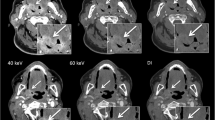Abstract
Objectives
We aimed to compare dual-energy computed tomography (DECT) virtual monochromatic imaging (VMI) and iodine density imaging (IDI) of oral cancers in terms of visual scoring and tumour volume estimation.
Materials and methods
Nine patients diagnosed with oral cancer who underwent DECT VMI and IDI were enrolled. One radiation oncologist, one head and neck surgeon and nine oral surgeons evaluated image clarity and quality in each patient in terms of metal artefacts due to dental prosthesis, internal tumour structure, tumour–organ boundary and total quality of images for diagnosis. Tumour volume was estimated using VMI, IDI and magnetic resonance imaging (MRI).
Results
The mean score for image artefact was significantly higher for IDI than for VMI in three observers, the mean score for internal structure was significantly higher for IDI than for VMI in five, the mean score for tumour–organ boundary was significantly higher for IDI than for VMI in two and the mean score for total quality of images for diagnosis was significantly higher for IDI than for VMI in five. Standard deviation of estimated tumour volume was not significantly different between VMI and IDI, but that of MRI was significantly lowest in three images.
Conclusions
In DECT for oral cancer, IDI has a visual image superior to VMI; thus, we recommend the use of IDI.
Trial registration
Clinical trial number: UMIN000038994.


Similar content being viewed by others
Abbreviations
- CT:
-
Computed tomography
- DECT:
-
Dual-energy computed tomography
- IDI:
-
Iodine density imaging
- MRI:
-
Magnetic resonance imaging
- OAR:
-
Organ at risk
- VMI:
-
Virtual monochromatic imaging
References
Shah JP, Gil Z. Current concepts in management of oral cancer—surgery. Oral Oncol. 2009;45:394–401.
Geets X, Daisne JF, Arcangeli S, et al. Inter-observer variability in the delineation of pharyngo-laryngeal tumor, parotid glands and cervical spinal cord: comparison between CT-scan and MRI. Radiother Oncol. 2005;77:25–31.
Bamberg F, Dierks A, Nikolaou K, et al. Metal artifact reduction by dual energy computed tomography using monoenergetic extrapolation. Eur Radiol. 2011;21:1424–9.
Nakayama Y, Awai K, Funama Y, et al. Abdominal CT with low tube voltage: preliminary observations about radiation dose, contrast enhancement, image quality, and noise. Radiology. 2005;237:945–51.
Toepker M, Moritz T, Krauss B, et al. Virtual non-contrast in second-generation, dual-energy computed tomography: reliability of attenuation values. Eur J Radiol. 2012;81:e398-405.
Stiller W, Schwarzwaelder CB, Sommer CM, et al. Dual-energy, standard and low-kVp contrast-enhanced CT-cholangiography: a comparative analysis of image quality and radiation exposure. Eur J Radiol. 2012;81:1405–12.
Yeh BM, Shepherd JA, Wang ZJ, et al. Dual-energy and low-kVp CT in the abdomen. Am J Radiol. 2009;193:47–54.
Graser A, Johnson TR, Chandarana H, et al. Dual energy CT: preliminary observations and potential clinical applications in the abdomen. Eur Radiol. 2009;19:13–23.
Graser A, Johnson TR, Hecht EM, et al. Dual-energy CT in patients suspected of having renal masses: can virtual nonenhanced images replace true nonenhanced images? Radiology. 2009;252:433–40.
Graser A, Becker CR, Staehler M, et al. Single-phase dual-energy CT allows for characterization of renal masses as benign or malignant. Invest Radiol. 2010;45:399–405.
Ascenti G, Krauss B, Mazziotti S, et al. Dual-energy computed tomography (DECT) in renal masses: nonlinear versus linear blending. Acad Radiol. 2012;19:1186–93.
De Cecco CN, Buffa V, Fedeli S, et al. Dual energy CT (DECT) of the liver: conventional versus virtual unenhanced images. Eur Radiol. 2010;20:2870–5.
Robinson E, Babb J, Chandarana H, et al. Dual source dual energy MDCT: comparison of 80 kVp and weighted average 120 kVp data for conspicuity of hypo-vascular liver metastases. Invest Radiol. 2010;45:413–8.
Tawfik AM, Kerl JM, Razek AA, et al. Image quality and radiation dose of dualenergy CT of the head and neck compared with a standard 120 kVp acquisition. AJNR Am J Neuroradiol. 2011;32:1994–9.
Tawfik AM, Kerl JM, Bauer RW, et al. Dual-energy CT of head and neck cancer: average weighting of low- and high-voltage acquisitions to improve lesion delineation and image quality-initial clinical experience. Invest Radiol. 2012;47:306–11.
Gnannt R, Winklehner A, Goetti R, et al. Low Kilovoltage CT of the neck with 70 kVp: comparison with a standard protocol. AJNR Am J Neuroradiol. 2012;33:1014–9.
Toepker M, Czerny C, Ringl H, et al. Can dual-energy CT improve the assessment of tumor margins in oral cancer? Oral Oncol. 2014;50:221–7.
D’Angelo T, Cicero G, Mazziotti S, et al. Dual energy computed tomography virtual monoenergetic imaging: technique and clinical applications. Br J Radiol. 2019;92:20180546.
Schmoee J, Dirrichs T, Fehrenbacher K, et al. Virtual monoenergetic images (VMI+) in dual-source dual-energy CT venography (DSDE-CTV) of the lower extremity prior to coronary artery bypass graft (CABG): a feasibility study. Acad Radiol. 2020;27:1249–1254.
Foti G, Beltramello A, Minerva G, et al. Identification of residual–recurrent cholesteatoma in operated ears: diagnostic accuracy of dual-energy CT and MRI. Radiol Med. 2019;124:478–86.
Lawrence S, Saskia L, Elisabeth V, et al. RECIST 1.1–update and clarification: from the RECIST Committee. Eur J Cancer. 2016;62:132–7.
Funding
None.
Author information
Authors and Affiliations
Corresponding author
Ethics declarations
Conflict of interest
None.
Ethical approval
Institutional ethical approval: yes. UMIN000038994.
Patient consent
Written informed consent was obtained from all participants.
Additional information
Publisher's Note
Springer Nature remains neutral with regard to jurisdictional claims in published maps and institutional affiliations.
Rights and permissions
About this article
Cite this article
Tanaka, O., Matsubara, M., Ehara, Y. et al. Usefulness of dual-energy computed tomography for oral cancer image. Oral Radiol 37, 585–590 (2021). https://doi.org/10.1007/s11282-020-00494-3
Received:
Accepted:
Published:
Issue Date:
DOI: https://doi.org/10.1007/s11282-020-00494-3




